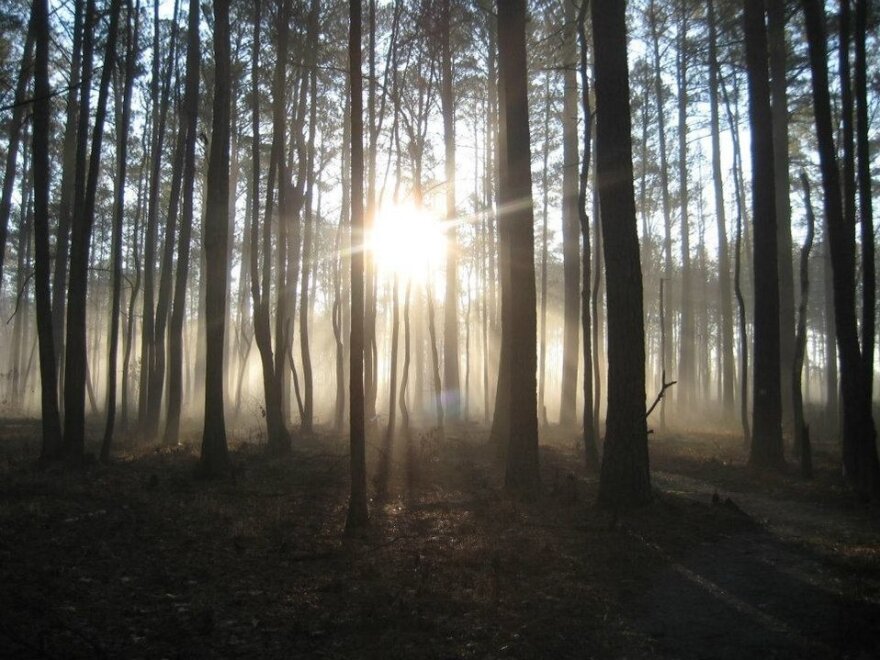About 250 miles northeast of Charlotte, you’ll find a place along the North Carolina-Virginia border called the Great Dismal Swamp. But it’s not as great as it used to be. Or as dismal. Or as swampy. So what’s there today?

Jeremy Markovich of Our State magazine took a trip to a place that’s still wild — and still revealing its secrets.
“Yeah, that’s a yellow biting fly,” Adam Carver said. “They tend to bite hard.”
When you go to exotic places, you meet exotic bugs. That yellow biting fly? It bit me hard. When I asked Carver how long it would take for the bite to go away, he said:
“Ah, a couple of days, it’ll stop itching tonight. But it’ll still be a little raised red bump for a couple of days. Part of the job.”
Carver’s job? Superintendent of the Dismal Swamp State Park, which is part of the Great Dismal Swamp. Which, at this moment, is full of yellow biting flies and ticks.
“Well, we do have a lot of bugs, but as you’ve also seen, it’s very quiet, and a very peaceful place and a good place to get away from the hustle and bustle of everyday life,” Carver said, “To get away from traffic, to get away from… there’s a fourth one.”
A fourth tick, he means. You might be wondering, who wants to come out here? Growing up in the area, Gary Meiggs used to ask the same question. He’s now a Camden County Commissioner.
[Related Content: 'Who In Their Right Mind Would Go Out Here?': A Hike To The Most Remote Part Of NC]
“A few years back if you would have mentioned eco-tourism here, we would have done our best to have laughed you out of this county,” Meiggs told me. “[Now,] it’s a very viable industry.”
And it’s true. When I drove out to the park, I found plenty of visitors — including Kathleen and Bruce Lee. When I talked to them, they said they were happy to be there, but admitted that they thought it would be a little more swampy.
Well, you can blame George Washington for that. According to Superintendent Carver, in 1763, long before he became our country’s first president, Washington and others decided to drain the swamp.
“They dug the canals and drained the water off the land in order to get to the timber,” Carver said.
Those canals, which are still there today, drained off a lot of water and made the swamp much, much smaller. It once covered more than a million acres. Today, only about 10 percent of that is left in North Carolina and Virginia. And so, the things you normally think of in swamps — like knee-high water, big cypress trees, and big cedar trees — are no longer there.
“That’s what the swamp used to be,” Carver said. “It’s just not what it is today.”
But the swamp does hold its share of secrets. Back in the visitor’s center, an archaeologist named Becca Peixotto is pulling artifacts — rocks and flakes — out of her bag.
“Any rock that’s in the swamp today had to have come from somewhere else,” Peixotto said.
Pexiotto once looked in the swamp for artifacts -- left behind by escaped slaves called Maroons, who purposely went into the swamp to hide, and lived there for years, knowing that most slave catchers, wouldn’t come looking for them there.
“The colonial Europeans did a really good job of portraying [the swamp] as a desert actually,” Pexiotto said, “As being devoid of life, as being uninhabitable, and it really wasn’t devoid of life at all.”
There are no buildings or wooden tools that remain from that era today, but from the pieces Peixotto and others found, we do know that the Maroons built cabins, cooked meat over fires and even made jewelry.
“This is a little nugget of soapstone that has been carved into a pendant, right? So these are not just people who are worried about finding or making projectile points to hunt, but they’re having some full lives,” she said. “They’re having families, they’re having lives, and they’re having reasons for personal adornment and all of that.”
The one thing that the swamp of the past has in common with the Great Dismal Swamp today? It is still really hard to penetrate. Back out in the field, Adam Carver wants to show me the remnants of an old rail line, so we go looking for a hole in the brush.
It takes a long time to go even 50 feet off of the logging road through vegetation so thick it feels like the plants are reaching out and grabbing us. As we’re working our way through, a vine wraps around his gun.
“You’ve never had the swamp yank the gun out of your holster, have you?” I ask Carver.
“I have a couple of times,” he said.
We never do find the rail line. And maybe that’s appropriate. The Great Dismal Swamp isn’t much of a swamp anymore, but it’s still a place where you can come and get away if you need to.
This story was adapted from “Away Message,” a podcast about North Carolina’s hard to find people, places, and things. You can listen to other stories by searching for “Away Message” on Apple Podcasts, Stitcher, or wherever you get your podcasts.




